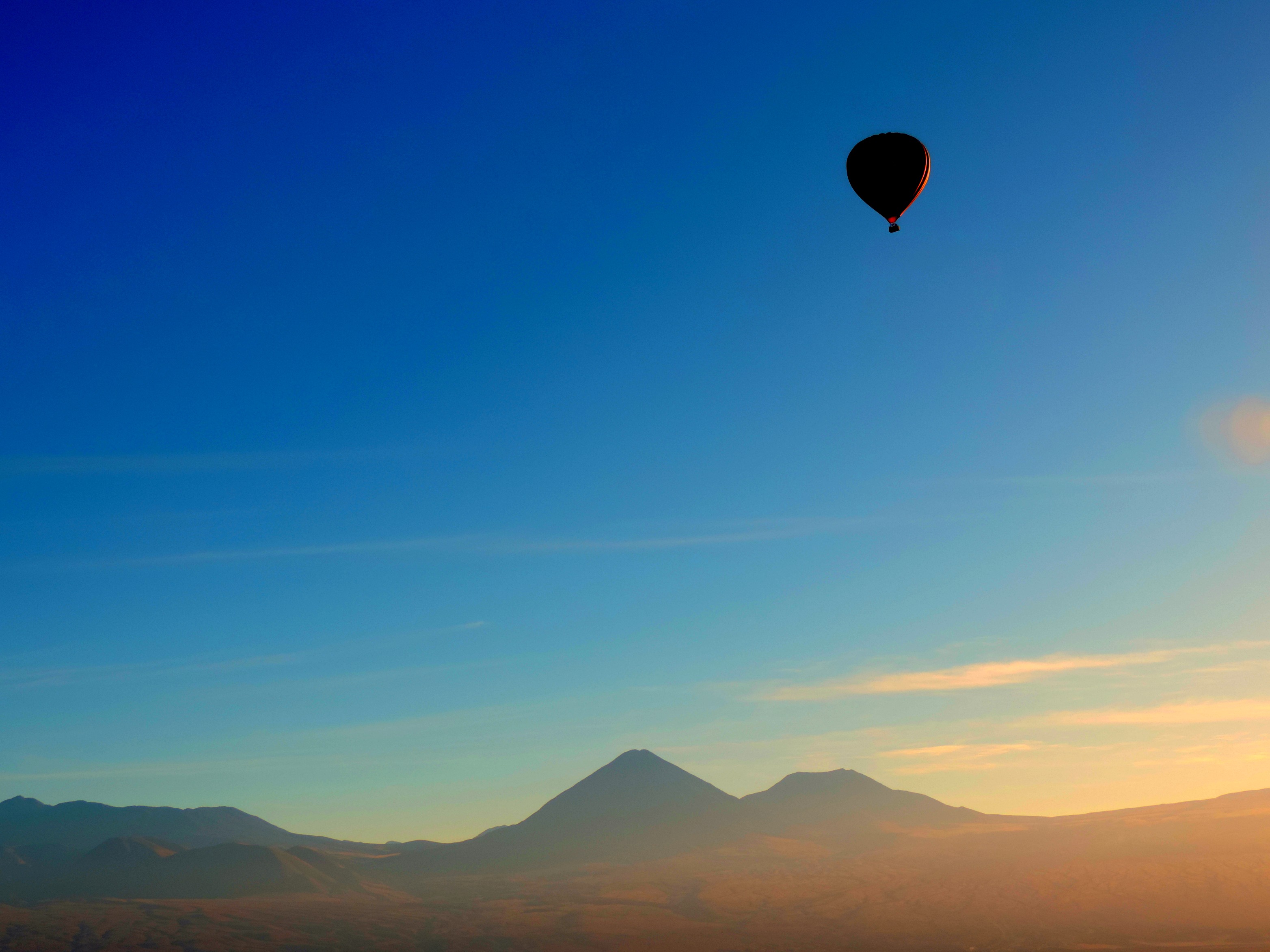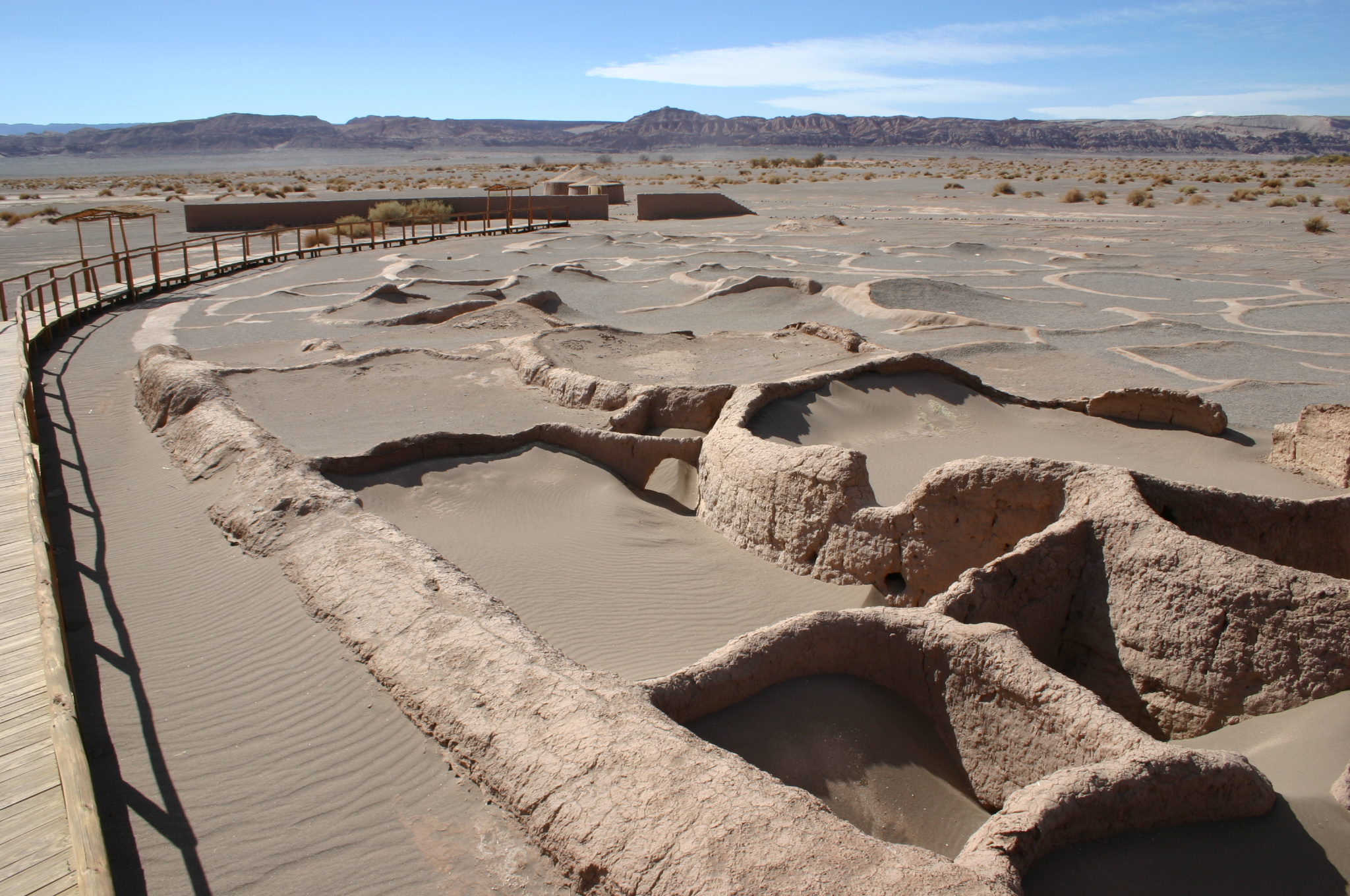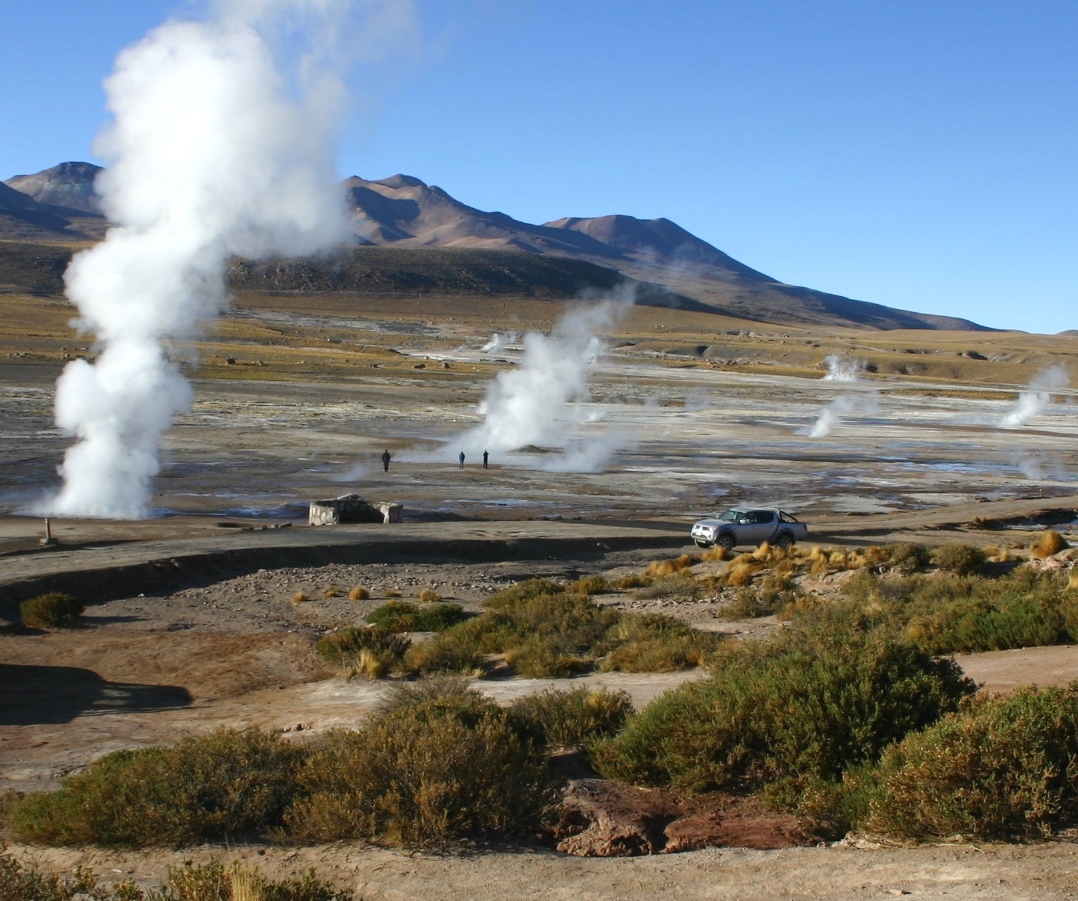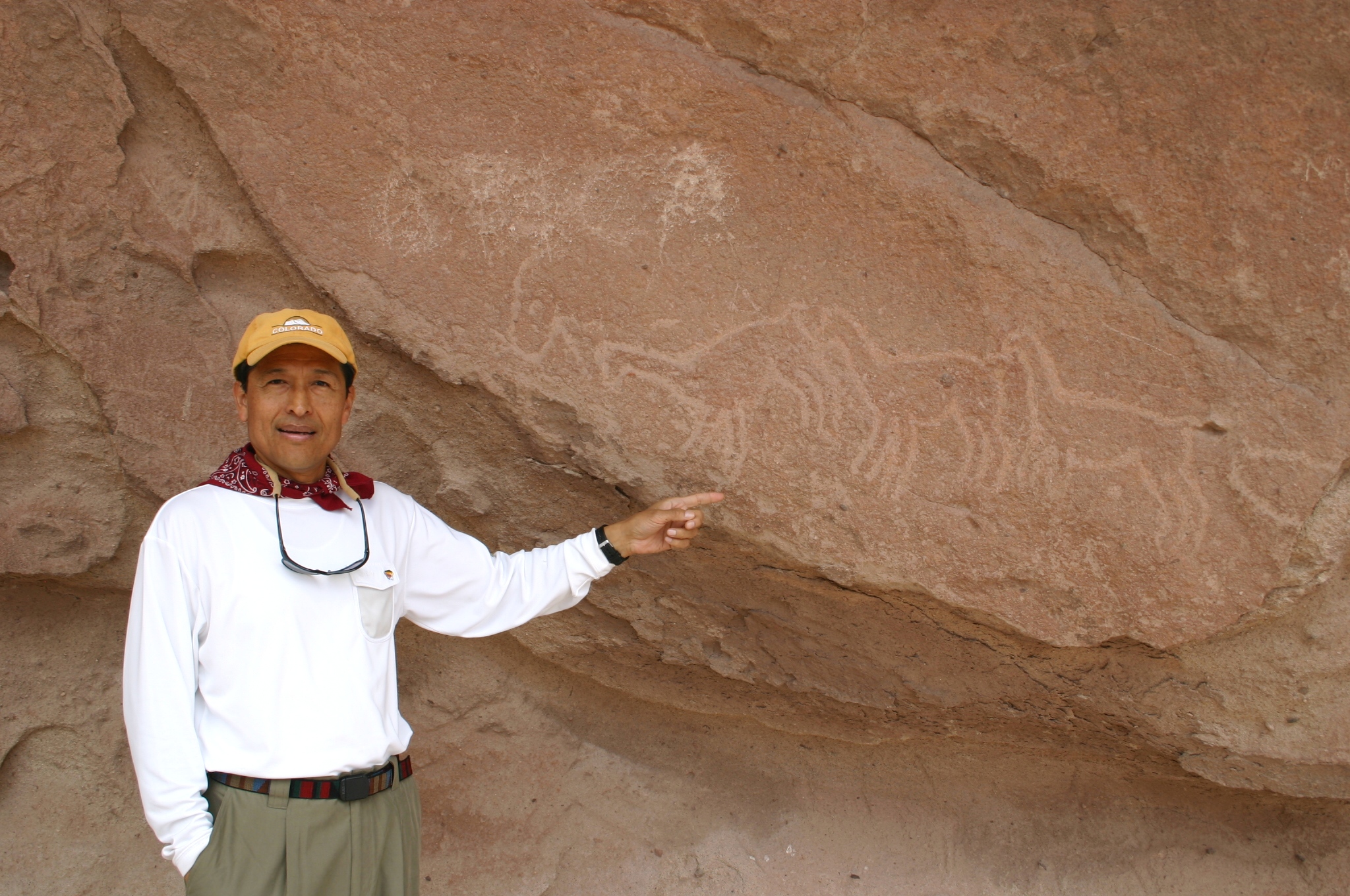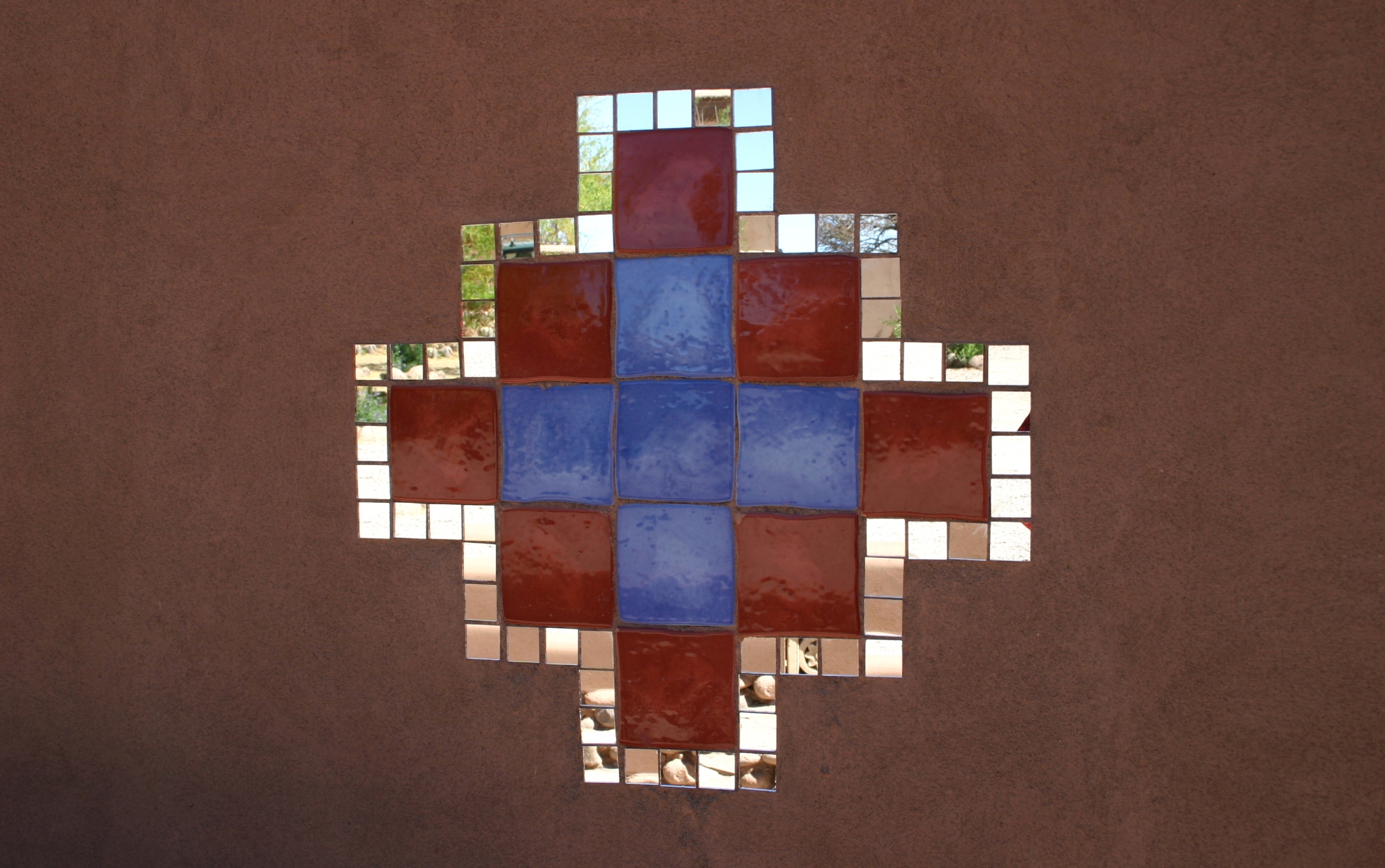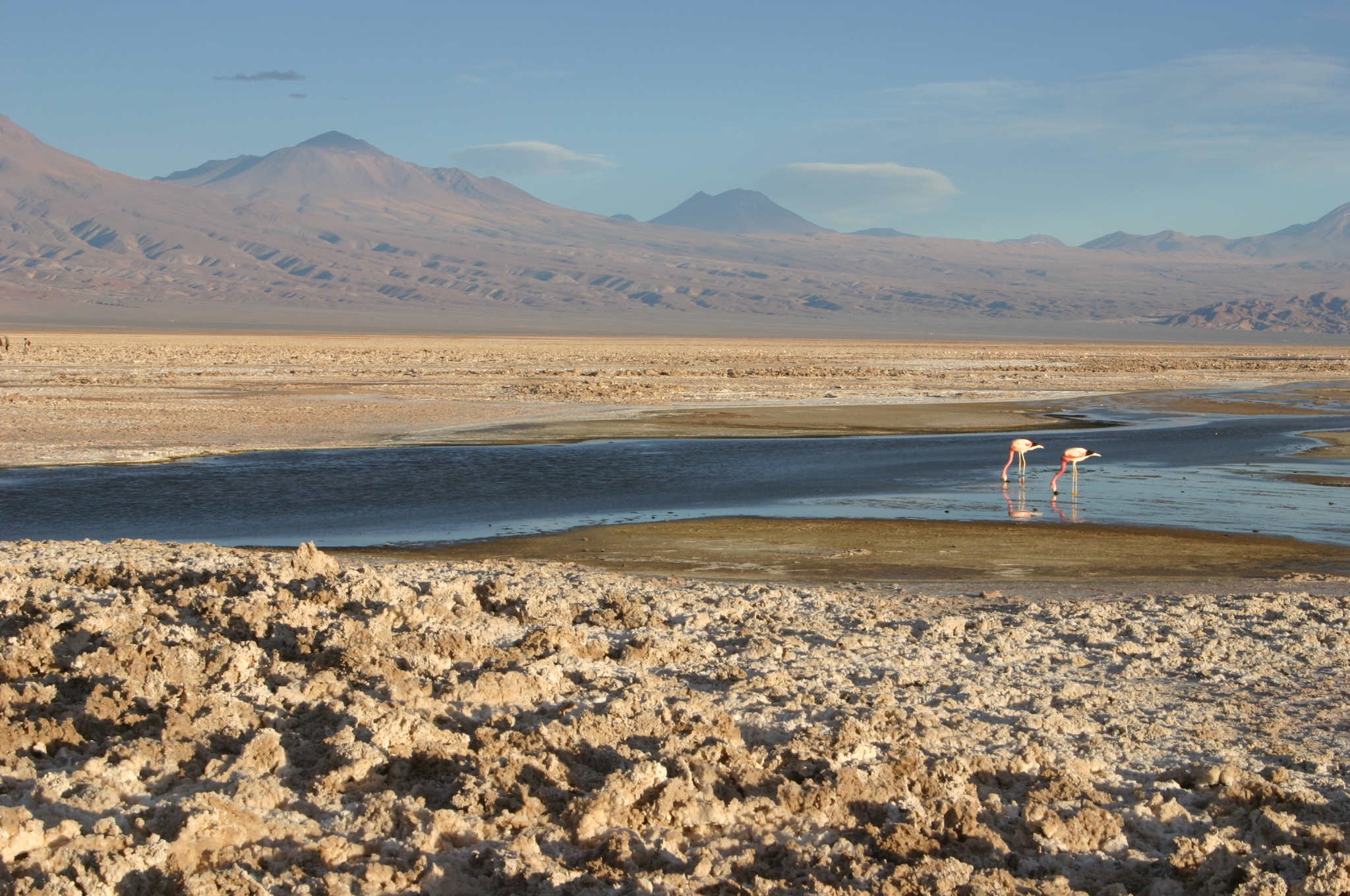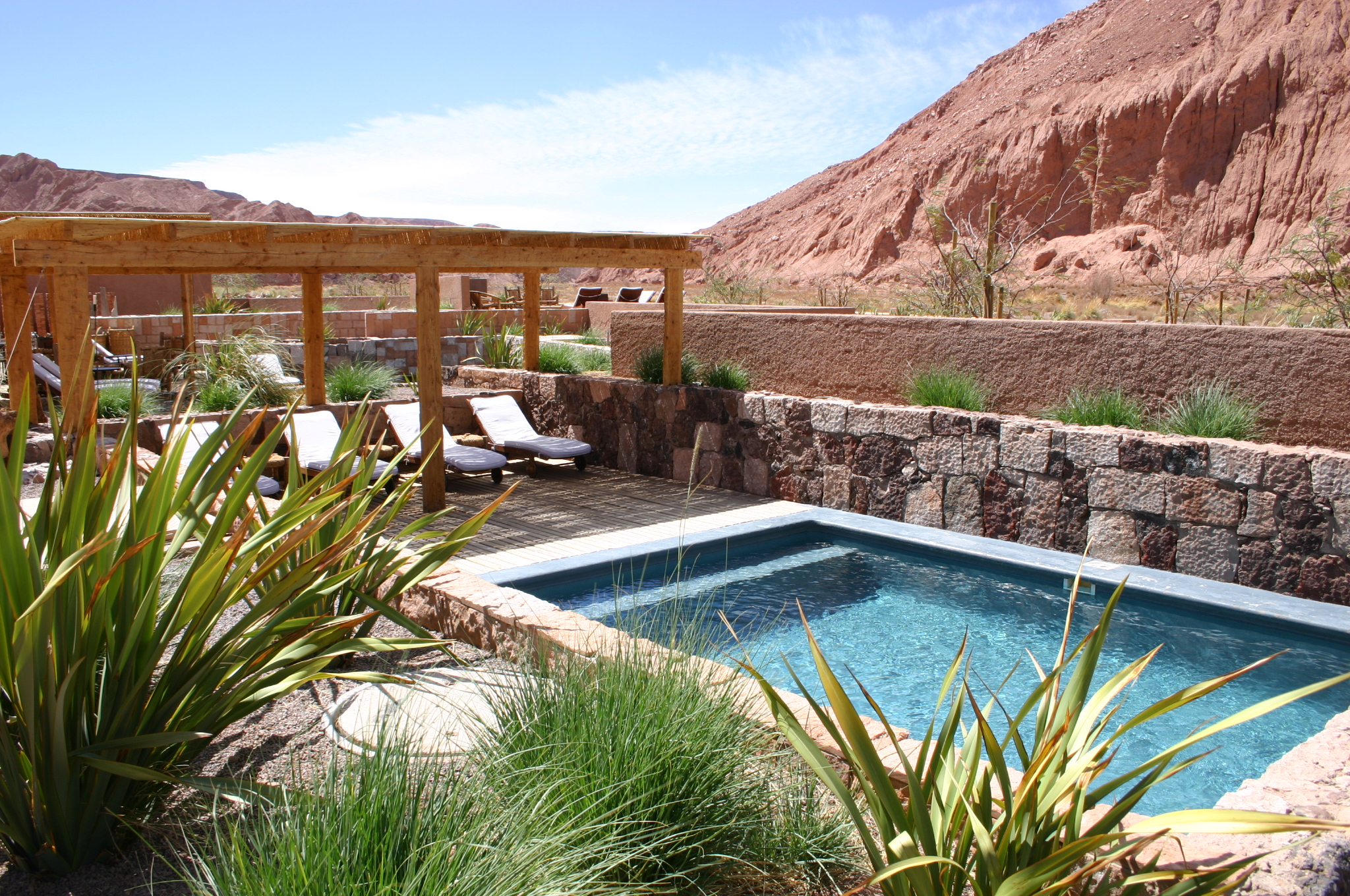by: Dana Johnson & Luis Felipa
Having such an otherworldly appearance, the majestic Atacama Desert of Northern Chile has been compared to the surface of Mars. So similar to our neighboring planet, NASA has even tested instruments designed for their Mars missions in this region. The Atacama Desert sees an average of less than .004 inches of rain per year and some areas have not had rainfall for over 400 years. As one of the rising travel destinations in South America, why should you visit Atacama? Below are the top reasons to explore this unique and magical place. It can be reached by a 2 hour flight from Santiago to Calama, followed by 1.5 hour scenic drive to San Pedro de Atacama (elev 7,898 ft), the base for our adventures.
1. Geographical Significance of the Desert
Covering over 40,500 sq. mi, the Atacama Desert is the oldest continuously arid region on earth—at least 3 million years old with some sections geologically dated to over 200 million years old, dating back to the Triassic period. The aridity of the Atacama occurs because of its placement between two mountain chains (The Andes and the Chilean Coast Range). These high altitude barriers create a two-sided rain shadow on the region preventing moisture from the Pacific or Atlantic Oceans to penetrate.
2. Archeological sites in Atacama
There are a number of archeological sites in the Atacama Desert, including Tulor, which features the remains of circular adobe buildings in the Valley of the Moon. Most of the structures are still buried under the sands and it’s believed Tulor was settled by indigenous people who grew maize and herded llamas some 2,800 years ago. A former Incan administrative center, Catarpe shows 200 structures which were built only in stone and adobe centuries ago. You can also visit the Incan fortress at Pukará de Quitor, located on a mountain side just 2 miles from San Pedro. It was built in the 12th century but taken over by Spain in the 16th century. Carved by the Atacameno people approximately 10,000 year ago, at Yerbas Buenas you can find more than 1,000 petroglyphs, many of them depicting native animals such as llamas, flamingos, and foxes.
3. The Chinchorro Mummies
The oldest mummies in the world have been found in the Atacama Desert. Mummies dating as far back as 7020 BC were naturally created due to the extremely dry climate and soil conditions. The Chinchorro culture was mummifying its deceased members over 2000 years before the Egyptians, with the oldest human-modified mummy dating back to 5050 BC. Unlike the Egyptians who mummified their elite, the Chinchorros mummified all members of their society. The Gustavo Le Paige Archaeological Museum in San Pedro de Atacama has some of the best-preserved artifacts in South America, but you won’t be able to see the mummies there due to the indigenous people’s concerns. The mummies are now housed in the San Miguel de Azapa Museum in Arica. A growing concern of scientists is climate change. A rise in humidity has caused bacteria to grow in patches on the mummies, causing their skin to turn to black ooze. Curators of the museum have determined climate control stops the bacteria from growing. A worry however continues for all of the undiscovered mummies still unfound in the desert sands.
4. Astronomical Observations
The La Silla Observatory, the Paranal Observatory and the Llano de Chajnantor Observatory are all located in Chile’s Atacama Desert. Due to the high altitude, lack of moisture in the air and non-existent light pollution, this desert is one of the best places in the world for stargazing. It’s such an attraction that the European Southern Observatory operates the Atacama Large Millimeter/submillimeter Array (or ALMA) here — the largest astronomical project in existence and more powerful than the Hubble telescope. ALMA is a single telescope of revolutionary design, composed of 66 high precision antennas located on the Chajnantor plateau near San Pedro.
Atacama is also one of the best locations on earth to appreciate our Milky Way’s glittering collection of stars. A perfect combination of altitude, dry air, and a lack of light pollution means the Atacama is one of the best stargazing locations on earth. April through September boasts of cloudless skies, making it a peak period to appreciate the stars, as well as Jupiter and Saturn. You won’t even need a telescope to see the breathtaking light show above. Darker skies are best for observations, so avoid visiting during a full moon. Many astronomical tours are available to teach you about the Milky Way and the constellations of the Southern Hemisphere.
5. El Tatio Geysers
The El Tatio (the grandfather) geysers are well worth braving chilly temperatures and an early start. Low morning temperatures prevent steam from the 80 geysers from evaporating, which creates an immensely magical, Instagram-worthy spectacle when the dawn’s rising rays hit the billowing clouds. At more than 14,000 ft above sea level, this is the world’s highest geyser field.
Walk among the geysers expelling clouds of steam up to 35 ft in the air, take pictures and wait for the sunrise spectacle. The visual impact of the geysers, thermal wells and steaming fumaroles at dawn, in the azure clarity of this high altitude desert, is unforgettable. The area is also home to a variety of hot springs. On excursions to El Tatio breakfast is served picnic-style.
Located in an indigenous zone, after visiting the geysers, you’ll also have an opportunity to stop at the local native community of Machuca, where you can taste a Llama shish-ka-bob, visit their church and mingle with the locals.
6. Inca History
The Inca Empire spread across several countries in South America and reached San Pedro de Atacama unfolding its political and religious beliefs in the period between 1450 and 1550 AD. During this century, the Inca Empire managed to control San Pedro and the various communities dwelling in the area.
In the past, it used to be a sacred place for the Inca Empire. The Incas would carry out religious ceremonies to worship the sun during the zenith of their power. The famous Licancabur volcano (19,410 ft above sea level), located some 25 mi away from the village of San Pedro, became an important ceremonial center for the Inca civilization.
7. Local Culture
Initially a mining town, San Pedro de Atacama is now a tourist destination with adobe style homes lining the narrow dusty roads. In the central plaza is one of the oldest churches in Chile (circa 1744). If visiting in June, you can participate in the annual San Pedro y San Pedro celebration, comprised of a weeklong event of Catholic processions, masses and colorful traditional folk dancing.
The town is home to various crafts created according to the people’s traditional faith. Believing in life after death, many adornments are created for burial to assist their loved one for their postmortem life. Handed down generation to generation, the locals have skills for making artifacts from volcanic stones and local cactus wood. Pottery, wood engraving, basketry, musical instruments, clothing, ornaments and weaving are some of the beautiful things you’ll find at the various shops. You’ll also discover original designs around town in doors, gates, adobe walls and patios.
Even the food scene is artisan-crafted, with chefs and owners creating foods from native plants grown only in the desert to create Andean fusion dishes. From quinoa salads, artisan pizzas, and homemade empanadas with unique ingredients, to fresh juices and smoothies made from things like kiwi and coca leaves, you’ll be pleasantly surprised at every meal.
8. Climb a Volcano to Gain Superpowers
Outside of San Pedro lies the majestic Licancabur Volcano (19,410 ft). Standing as a beacon in the distance, this volcano sits on the border between Chile and Bolivia. Considered holy by the indigenous Atacameno people, Licancabur has numerous archeological sites on its slopes. Inactive, the cone is capped with a crater lake. Due to the high altitude this is considered one of the highest lakes in the world. Locals believe climbing the volcano and drinking water from this lake will give one superpowers. If this is your mission, be sure to wear your sunscreen and carry a water filter to safely drink the water.
Other friendlier volcano ascensions in the area include:
- Toco (18,538 ft), from the top enjoy great views of the Bolivian Altiplano and the Atacama Salt Flat to the west.
- Lascar (18,348 ft), Chile´s most active volcano, featuring lively smoke vents and multiple craters as well as a panoramic view of the Salar de Atacama and Laguna Lejía.
- Corona (17,360 ft), Amazing views of the entire volcanic arc of the Andes awaits those reaching its summit, including Lascar Volcano.
- Jurinquinca (16,372 ft), this volcano gives panoramic views and good chances to see native flora and wildlife such as vicuñas.
9. Surf a Sand Dune
The Cerro Medanoso sand dune in the Atacama Desert is the tallest in Chile and is considered the second highest sand dune in the world. Besides being a site to behold and a unique photographic opportunity, the Cerro Medanoso also makes for great sandboarding.
Just 1.2 miles outside San Pedro lies the Valle de Los Muertos, Death Valley, one of the best places in the country to practice this sport, a sand boarder’s dream. The stark landscape of eroded lava and sandstone formations sit nestled among smooth sand dunes that stretch for miles. These slopes allow you to see the unique colors and textures of the Atacama Desert at sundown and those ascending the dunes get rewarded by a panoramic view of the breathtaking landscape. Boards can be rented in town or just come to the valley to watch the locals cutting it up down the dunes.
10. Salt Flats and Flamingos
Near San Pedro sits a 1,200 square mile salt lake, though what you’ll find won’t look like any lake you’ve seen before. Surrounded by mountains filled with sodium and other minerals, this lake fills when there is the rarest of rains in the Atacama Desert. The soil doesn’t absorb the rainwater quickly so flash flooding occurs and the water settles in the lake bed, only to evaporate. The large amounts of salt, sand and other minerals are left behind giving this lake a look like the lunar surface and the Salar de Atacama, Chile’s biggest salt flat. A few springs in the middle of this impressive salt flat give way to open areas of water with a plethora of small crustaceans upon which the Andean, Chilean and James species of flamingos feast. Many flamingos flock here, thus the creation of the National Reserve for Flamingos in 1990.
11. Boutique Lodges
The Atacama Desert offers some of the most unique, environmentally friendly, comfortable and well-designed hotels in South America. Most are pueblo or adobe style and blend in with the natural landscape. They offer amazing service, original cuisine, warm décor and spas, not to mention any number of activities to keep you busy during the day and night.
Cumbres San Pedro- Located at the edge of town, this hotel features a mix of Atacameño ancient architecture blended with modern style. 60 spacious rooms boast of large floor plans for a private retreat. Relax at one of the 3 heated pools or enjoy a service at the spa. As a full-service hotel the Cumbres also offers activities for exploration in the surrounding desert as well as a 5-star restaurant.
Tierra Atacama- A 32-room boutique hotel and spa, on the outskirts of San Pedro, gives a nod to its original function as a cattle corral by incorporating its traditional adobe walls into the property’s entrance. Guests are offered daily excursions or can just kick back beside terrace fire pits and lounge next to a pool with some the finest desert views and the stunning sight of the Licancabur volcano in the distance. The grounds, with ancient algarrobo and chañar trees, include 10 acres for growing quinoa, corn, and herbs, all watered by snow melt.
Awasi Atacama- A Relais & Chateux luxury lodge, specializing in a tailor-made private experience with private excursions and guides for each guest, this hotel is in town inside an ancient site with a preserved historic wall once housing shepherds. Exclusivity is Awasi’s specialty with only 8 suites available. This allows for privacy, serenity and deep relaxation. Chef, Juan Mardones, prepares food incorporating the desert fauna and flavors making the gastronomy an experience in and of itself.
Alto Atacama Desert Lodge and Spa- A relaxing retreat two miles outside of town in the Catarpe Valley and set against the nearby hills, this lodge is an ideal place for stargazing the unforgettable Atacama night sky. The terracotta-hued lodge blends into the desert landscape for a tranquil setting. The 42-room, luxurious property is surrounded by gardens with native plants and hand-carved local bricks and tiles. Six outdoor pools and a Jacuzzi add an intense cyan to the ochre palette. A stable of llamas and alpacas is popular with guests as is the lodge’s 30 exciting excursions with experienced guides.
Explora Atacama- With 50 rooms, this is one the largest and most comfortable lodges in the area. Explora offers a chic contemporary ambiance, featuring four solar heated outdoor pools and an astronomical observatory. It’s a convenient base for exploring the surrounding region. Located 15 min from town on 42 acres of desert oasis, Explora is known for its unbeatable explorations. With over 40 explorations offered on foot, bike or horseback, you’re bound to discover the natural gems of the Atacama Desert.
12. Mystical Aspects of the Desert
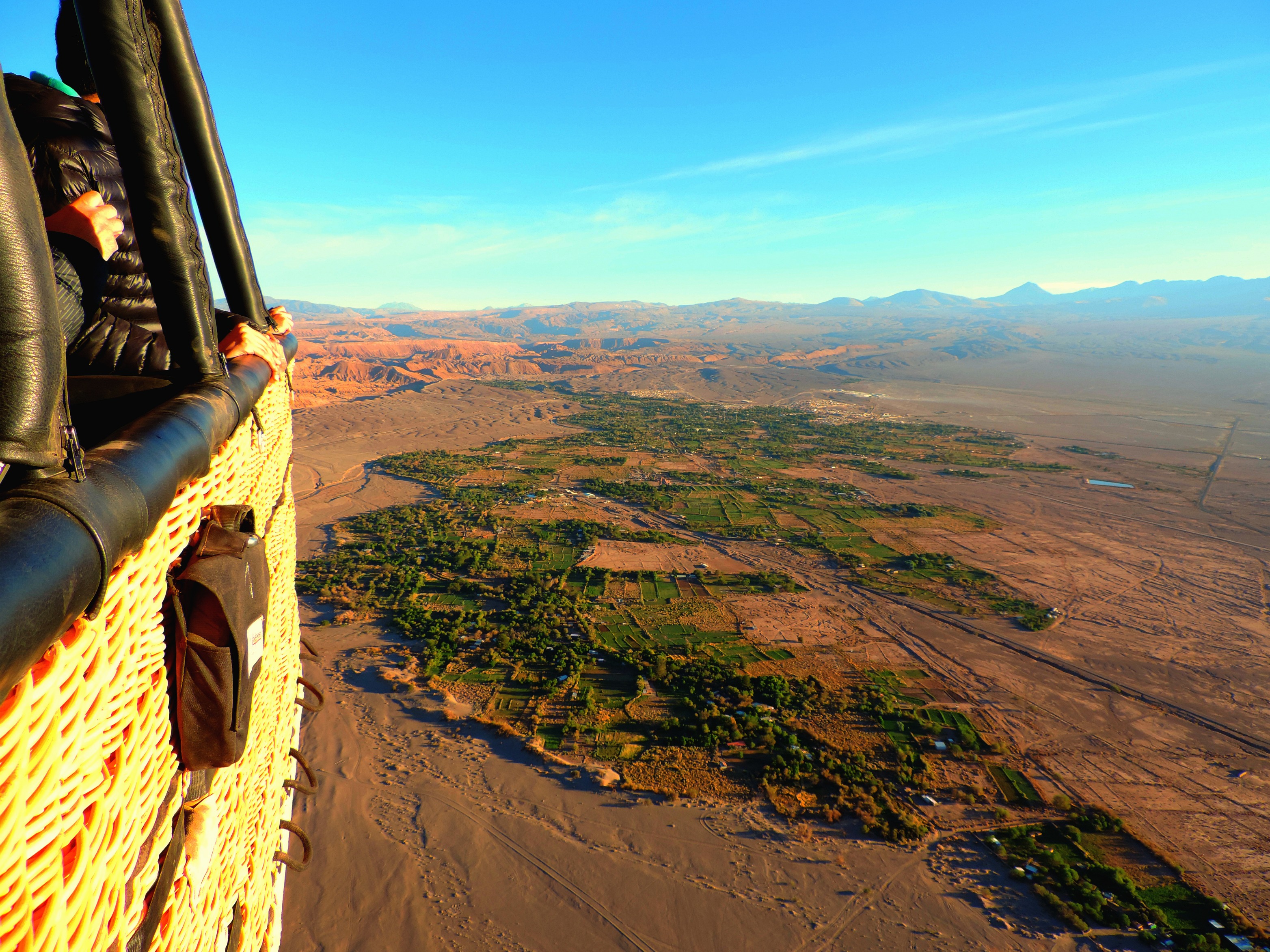
This has been a sacred land for centuries. Feeling the magnetism and the natural power of the elements makes Atacama majestic. Go there to find harmony, balance, relaxation, inspiration, and healing. A popular place for meditation, the striking silence and the hot air offer mystical answers to your deepest questions. It is difficult to find places on earth with such vast emptiness, allowing your mind to re-order its thoughts and offer peace to an otherwise intense life. The incredibly clear night skies allow you to comprehend your tiny part of the immense universe. Pondering infinity is humbling and good for the soul.
The Atacama Desert is an amazing destination, great for couples on romantic escapes, families traveling together and looking for experiences for all generations, adventure seekers, hikers, explorers of natural and pristine environments, natural history aficionados and astronomy lovers. These 12 highlights don’t even begin to list all of the unique experiences available. No matter your desire, whether it be adventure like ballooning over the desert, mountain biking along the canyons, staying at one of the many cozy lodges, or relaxing at one of the desert spas, you’ll be able find it here.
Southwind Adventures has been leading tours to the Atacama Desert and Chile for over 15 years. Contact one of our Travel Consultants to begin the creation of a perfect itinerary to the driest place on earth today.

